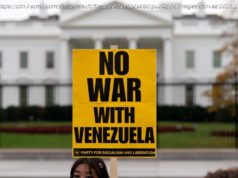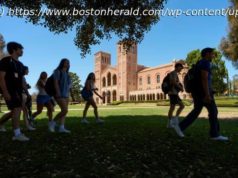Natalie Vanderstay told the AP she remembers being trampled and shot and summoning a survival instinct to find a way out
LAS VEGAS — Tubes connecting to veins in her arms, Natalie Vanderstay clutches a pillow to her stomach, over the spot where a bullet entered her body. Blankets cover the leg that was ripped apart, doctors believe by shrapnel.
The 43-year-old Los Angeles nurse can hardly believe she’s alive. In the past 48 hours, she said, her life has changed forever.
She saw corpses and people dying as she fled the massacre on the Las Vegas Strip. She recalls being trampled and shot and then summoning a survival instinct to find a way out. She stepped on people to save herself, which is something that may haunt her forever.
“I said, ‘OK, I can’t stay here. I’m going to bleed out.’ It hurt so bad,” Vanderstay told the Associated Press, weeping from her bed at University Medical Center on Tuesday. “But I knew I didn’t want to die. I wasn’t ready to die.”
The staggering count of people injured in the shooting at a Las Vegas music festival on Sunday means their recoveries are likely to be as varied as the victims themselves. Some injuries are as simple as broken bones, while others are gunshot wounds involving multiple surgeries and potential transplants. All come with the added emotional scars of enduring the deadliest shooting in modern U. S. history, with 59 killed.
Vanderstay is one of more than 500 people injured that night. At least 130 people remained hospitalized Tuesday, with 48 listed in critical condition. At Sunrise Hospital and Medical Center alone, the count of those treated included 120 people who were struck by gunfire, a glimpse of the amount of ammunition unleashed in the attack.
Rehabilitation for the most seriously hurt victims will take far longer than many may realize.
“Years,” said Dr. Thomas Scalea, physician-in-chief at the University of Maryland’s Shock Trauma Center in Baltimore, one of the nation’s largest trauma centers. “It’s not days or weeks.”
For Vanderstay, there are physical wounds that she as a nurse knows will take many weeks or longer to heal. She underwent surgery to have her colon and small intestine resectioned, meaning portions were removed.
Then there are the memories of how it happened and how one night out with friends at a concert turned into a siege.
“People were screaming. And the screams got louder and louder,” she said. “I felt this force in my stomach and I knew that I had gotten shot.”
When the gunfire ripped into her, “it felt like a huge baseball, just the force of it going through my stomach.” She could see that her leg had been “fileted open,” she said, and she recalled taking off her flannel shirt to tightly wrap the leg.
As Vanderstay spoke, her words turn clipped and chaotic, echoing the frenzy of that night. Her voice quivered as she thought of the people she couldn’t help.
“There were people that were dead. There was a guy, his eye was blown out, and I couldn’t help him,” she said.
At the site of the attack, people fashioned stretchers out of fence posts and tarps and made tourniquets out of belts. At area hospitals, the scene was similarly grave.
“They were coming in so fast,” said Dr. Jay Coates, a trauma surgeon at University Medical Center of Southern Nevada, who operated on three people with gunshot wounds. “We were just trying to keep people from dying.”
To get out alive, Vanderstay willed herself to jump over a fence and escape the concert ground. She then hunkered down with a group of strangers, waiting for the seemingly endless gunfire to stop.
Once bullets stopped raining down from overhead, Vanderstay spotted a cab with three people already inside. She told them she’d been shot and needed to get to a hospital. The strangers took her in and put pressure on her stomach wound, and the quick-thinking cab driver knew not to take her to the nearest hospital but to University Medical Center, the only Level I trauma center in the state.
“If it wasn’t for that cab driver, I wouldn’t be here,” she said, breaking down. “And I don’t know who he is. He did everything to get me here.”
For those wounded by bullets, their prognoses depend heavily on where exactly the bullets struck.
“It really is a game of millimeters and centimeters,” said Dr. Jack Sava, trauma director at MedStar Washington Hospital Center in Washington, D. C.
Vanderstay said she woke up feeling immense gratitude, for all the strangers and good Samaritans who helped her stay alive and for all the nurses and doctors at the hospital who saved her life.
“I just remember waking up and my friends were there saying, ‘You made it. You’re OK,'” Vanderstay said. The next step is healing. “The road to recovery is going to be tough, mentally and physically.”
Her story echoes that of another survivor, Kristin Babik, who told “CBS This Morning” co-host Norah O’Donnell she’s just thankful to have survived, despite being shot in the back and nearly becoming paralyzed.
Disbelief is how Babik describes the moment she heard the first spray of gunfire on Sunday.
“I felt like a splatter or something wet drip down where I was hit. So I was like oh, maybe someone threw their drink or maybe someone’s just being silly,” she said. “I started running toward the back. And I realized I couldn’t breathe.”
Bleeding and fighting for air, Babik continued running alongside her friend Joseph Ostunio .
“We made our way to a fence because the other exits were too full and there were people on the other side helping people get over. And someone caught me. And I was so scared. And they gave me the biggest hug. And they told me everything’s gonna be okay,” she recounted.
The law student says surviving Sunday’s shooting has renewed her sense of purpose to become a criminal prosecutor after she graduates in May.






